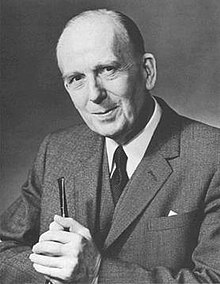William Cook | |
|---|---|
 | |
| Born | 10 April 1905 Trowbridge, Wiltshire, England |
| Died | 16 September 1987 (aged 82) London |
| Alma mater | Bristol University |
| Known for | Hydrogen bomb Rolls-Royce RB211 |
| Awards | Companion of the Order of the Bath (1952) Knight Bachelor (1958) Fellow of the Royal Society (1962) Knight Commander of the Order of the Bath (1970) |
| Scientific career | |
| Institutions | Aldermaston |
Sir William Richard Joseph Cook, KCB FRS (10 April 1905 – 16 September 1987) was a British civil servant and mathematician.
A graduate of Bristol University, he joined the staff of the Woolwich Arsenal in 1928, working on the 6-inch naval guns and the 3-inch anti-aircraft rocket. During the Second World War he was deputy controller of the Projectile Development Establishment. After the war, he became director of the Ministry of Supply's Rocket Propulsion Establishment at Westcott, Buckinghamshire. In 1947 he joined the Royal Naval Scientific Service, serving as its chief from 1950 to 1954, when he became deputy head of the Weapons Group of the newly created United Kingdom Atomic Energy Authority (UKAEA). It was under his leadership that Britain developed the hydrogen bomb, and he was present as the scientific director of the Operation Grapple nuclear tests at Malden Island in May and June 1957, and the successful thermonuclear test at Christmas Island in November 1957. In 1958, he became the UKAEA's Member for Engineering and Production, and oversaw the expansion of the civil nuclear power industry.
Cook returned to the Ministry of Defence in 1960 as one of two deputies to the Chief Scientific Adviser to the Ministry of Defence. Cook served as the Chief Scientific Adviser to the Ministry of Defence from 1966 until 1970, when he retired from the civil service. He oversaw the development of weapons such as the Panavia Tornado, Rapier surface-to-air missile, SEPECAT Jaguar and FH70 howitzer. After Rolls-Royce went bankrupt in 1970, he chaired a committee that determined that the Rolls-Royce RB211 engine should be continued. When Rolls-Royce was nationalised in 1971, he was appointed as a director or the company; he retired in 1976, but continued to assist the company for four more years. He was also a director of GEC Marconi Electronics from 1972 to 1979, and Marconi International Marine from 1971 to 1975, and a consultant to British Telecom from 1982 to 1985.